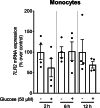Fructose intake enhances lipoteichoic acid-mediated immune response in monocytes of healthy humans
- PMID: 40517600
- PMCID: PMC12205830
- DOI: 10.1016/j.redox.2025.103729
Fructose intake enhances lipoteichoic acid-mediated immune response in monocytes of healthy humans
Abstract
Metabolic diseases like type 2 diabetes are afflicted with higher rates of infections and longer, more complicated infection course as well as higher fatality rates. The impact of nutrition and specific nutrients like free fructose herein has not yet been fully understood. Here, we performed dietary intervention studies in healthy individuals and performed ex vivo experiments in isolated blood immune cells to assess the effects of dietary fructose intake on Gram-positive bacterial toxin induced immune responses. Acute and extended intake of fructose but not glucose was related with an induction of Toll like receptor 2 mRNA expression in monocytes and enhanced the LTA-dependent release of proinflammatory cytokines from monocytes. Blocking fructose metabolism and transcription factor SP1 attenuated the fructose-related induction of Toll like receptor 2 mRNA expression and augmentation of proinflammatory cytokine release further suggesting that fructose-dependent metabolic alterations are critical in enhancing immune responsiveness of humans after fructose consumption.
Keywords: Gram-positive bacteria; Ketohexokinase; Lipoteichoic acid; SP1; Sugar; Toll like receptor 2.
Copyright © 2025 The Authors. Published by Elsevier B.V. All rights reserved.
Conflict of interest statement
Declaration of competing interest All authors declare no conflict of interest.
Figures







Similar articles
-
Nutritional interventions for survivors of childhood cancer.Cochrane Database Syst Rev. 2016 Aug 22;2016(8):CD009678. doi: 10.1002/14651858.CD009678.pub2. Cochrane Database Syst Rev. 2016. PMID: 27545902 Free PMC article.
-
Dietary interventions for recurrent abdominal pain in childhood.Cochrane Database Syst Rev. 2017 Mar 23;3(3):CD010972. doi: 10.1002/14651858.CD010972.pub2. Cochrane Database Syst Rev. 2017. PMID: 28334433 Free PMC article.
-
A systematic overview of chemotherapy effects in acute myeloid leukaemia.Acta Oncol. 2001;40(2-3):231-52. doi: 10.1080/02841860151116321. Acta Oncol. 2001. PMID: 11441935
-
Effect of fructose consumption on insulin sensitivity in nondiabetic subjects: a systematic review and meta-analysis of diet-intervention trials.Am J Clin Nutr. 2016 Dec;104(6):1562-1576. doi: 10.3945/ajcn.116.137786. Epub 2016 Nov 9. Am J Clin Nutr. 2016. PMID: 27935520
-
Antidepressants for pain management in adults with chronic pain: a network meta-analysis.Health Technol Assess. 2024 Oct;28(62):1-155. doi: 10.3310/MKRT2948. Health Technol Assess. 2024. PMID: 39367772 Free PMC article.
References
-
- Organization W.H. The top 10 causes of death. 2024. https://www.who.int/news-room/fact-sheets/detail/the-top-10-causes-of-death
LinkOut - more resources
Full Text Sources

